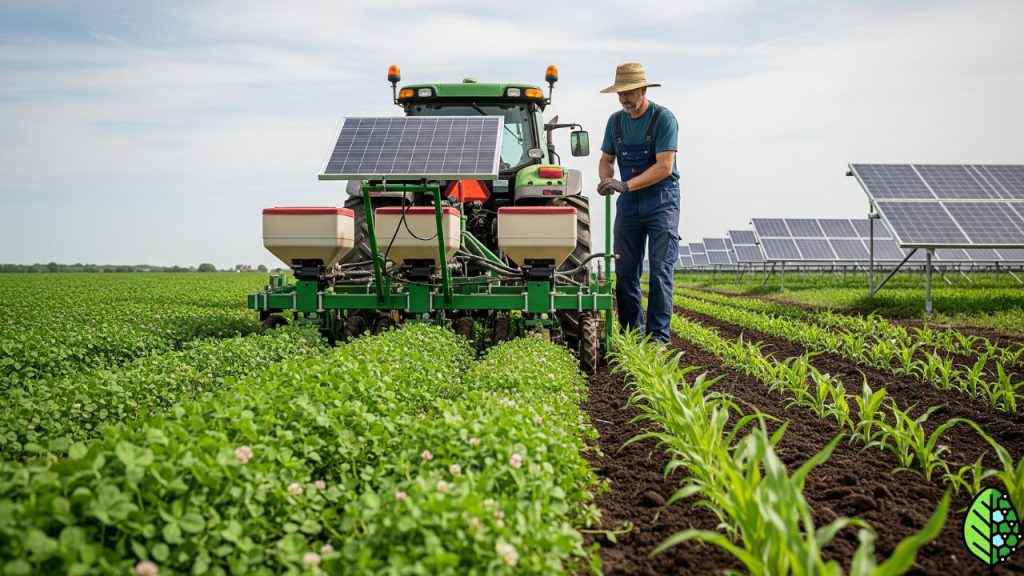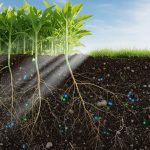Have you ever wondered how you can make your farm more eco-friendly? The answer might be simpler than you think.
As a farmer, your daily choices have a direct impact on the environment. By taking small, manageable steps, you can significantly reduce your carbon footprint while maintaining—or even boosting—your farm’s productivity. This not only benefits the planet but also enhances your farm’s sustainability, potentially saving you money in the long run.
Intrigued? Keep reading to discover practical, easy-to-implement strategies that can transform your farming practices and help you contribute to a greener future.
Sustainable Soil Practices
Understanding sustainable soil practices can lead to healthier crops. They also reduce carbon emissions significantly. These practices help maintain soil fertility, conserve resources, and support ecosystems. Farmers adopting these methods contribute to a greener planet. This approach not only benefits the environment but also boosts farm productivity.
Crop Rotation
Crop rotation involves changing the crops grown in a field each season. This prevents soil depletion and improves nutrient content. Different crops use and replenish different nutrients. Rotating crops helps maintain soil balance. It reduces the need for chemical fertilizers, thus cutting carbon emissions.
Cover Cropping
Cover crops are planted to cover soil during off-season. They prevent erosion and enhance soil structure. These crops add organic matter to the soil. This increases carbon sequestration. Cover cropping also reduces weeds and pests naturally. It creates a healthier farming environment.
Reduced Tillage
Reducing tillage minimizes soil disturbance. This helps maintain soil structure and moisture levels. Less tillage means less fuel usage. This results in lower carbon emissions. It also preserves beneficial soil organisms. These organisms improve soil health and fertility.
Organic Farming
Organic farming avoids synthetic chemicals. It relies on natural processes to improve soil health. Compost and manure enrich the soil organically. Organic methods enhance biodiversity and carbon storage. This reduces the farm’s overall carbon footprint.
Agroforestry
Agroforestry integrates trees with crops or livestock. Trees absorb carbon dioxide effectively. They improve soil structure and fertility. This practice provides shade and reduces erosion. It enhances biodiversity and ecosystem resilience. Agroforestry supports sustainable farming goals.

Efficient Water Management
Farmers can cut their carbon footprint by using water wisely. Collect rainwater for crops. Fix leaks to save water.
Efficient water management is crucial for farmers looking to reduce their carbon footprint. By optimizing water usage, farmers not only conserve this precious resource but also decrease energy consumption linked to water pumping and distribution. This section will delve into practical methods you can adopt to manage water more efficiently on your farm.
Use Drip Irrigation Systems
Drip irrigation delivers water directly to the plant’s roots, minimizing waste. This method ensures that plants receive the exact amount of water needed, reducing overwatering. By adopting drip irrigation, you can cut down water usage by up to 50% compared to traditional methods.
Schedule Watering Times
Watering your crops during cooler parts of the day, such as early morning or late afternoon, reduces evaporation. This ensures that more water reaches the plants rather than evaporating into the atmosphere. Scheduling your watering times can significantly enhance water efficiency and ensure crops receive adequate hydration.
Collect Rainwater
Rainwater collection is a cost-effective way to supplement your water supply. Install rain barrels or tanks to capture runoff from roofs and other surfaces. Using stored rainwater can help reduce reliance on groundwater and municipal water, thus conserving energy and reducing your carbon footprint.
Monitor Soil Moisture
Using soil moisture sensors can help you determine when your crops actually need water. This prevents unnecessary watering, saving water and energy. By ensuring that irrigation only occurs when necessary, you can optimize water usage and improve crop health.
Implement Cover Crops
Cover crops not only enrich the soil but also help retain moisture. They reduce the evaporation rate, keeping the soil hydrated for longer periods. By planting cover crops, you can enhance soil structure and water retention, leading to less frequent watering.
Regular Maintenance Of Irrigation Systems
Check your irrigation systems regularly for leaks or blockages. A well-maintained system ensures water is distributed evenly and reduces waste. By fixing leaks promptly, you can prevent water loss and ensure efficient water use on your farm.
How do you currently manage water on your farm? Could these techniques make a difference in your operations? Efficient water management not only benefits the environment but also boosts your farm’s productivity and sustainability.
Adopting Renewable Energy
Farmers can cut their carbon footprint by adopting renewable energy solutions. Installing solar panels on barns and using wind turbines can help. Switching to electric tractors reduces emissions and supports sustainable practices.
Adopting renewable energy is a powerful way for farmers to reduce their carbon footprint. As the world shifts towards sustainable practices, integrating renewable energy sources can significantly lower greenhouse gas emissions. By tapping into nature’s resources like solar, wind, and bioenergy, you can lead your farm into a greener future while potentially lowering operational costs.
Utilizing Solar Panels
Solar panels can transform sunlight into electricity right on your farm. This clean energy source can power everything from irrigation systems to farm machinery. Installing solar panels might seem daunting at first, but think about the long-term benefits. Not only do they reduce your reliance on fossil fuels, but they also cut down your electricity bills over time.
Imagine the satisfaction of seeing those panels glisten under the sun, knowing that each ray contributes to a more sustainable planet. Have you considered the possibility of selling excess energy back to the grid? This could turn into an additional income stream, making your farm not just eco-friendly but more profitable.
Exploring Wind Energy
Wind turbines have become increasingly popular in the agricultural sector. They harness the power of the wind to generate electricity. If your farm is situated in a windy area, this option could be worth exploring. Picture towering turbines gracefully spinning, providing a steady stream of energy.
Wind energy is not only renewable but also reliable in the right locations. Could your farm benefit from this natural resource? Investing in wind turbines could be a game-changer, offering a sustainable solution that aligns with your green goals.
Leveraging Bioenergy
Bioenergy involves converting organic materials like crop residues and animal waste into usable energy. It’s a unique approach that turns waste into a valuable resource. Consider the amount of waste your farm produces annually. Could it be transformed into energy?
By adopting bioenergy, you not only manage waste more effectively but also create a renewable energy source. This can further reduce your carbon footprint and enhance sustainability. The process might seem complex, but the rewards are substantial. Imagine reducing waste disposal costs while powering your farm with energy derived from your own materials.
Evaluating Costs And Benefits
Before jumping into renewable energy, evaluate the costs and benefits. Assess the initial investment versus the long-term savings. Are solar panels or wind turbines financially feasible for your farm?
Understanding the financial aspect is crucial. Renewable energy might require upfront costs, but the potential savings and environmental benefits are worth considering. What if the investment pays off in reduced energy bills and increased farm value?
Making The Switch
Transitioning to renewable energy is a significant step. Begin by researching the options and seeking expert advice. How can you start small to see how it fits your farm’s needs?
Making the switch involves planning and commitment. But the journey towards a sustainable future begins with a single step. Are you ready to lead the charge in transforming agriculture for the better?
By adopting renewable energy, you contribute to a healthier planet while advancing your farming operations. It’s not just about reducing your carbon footprint; it’s about creating a legacy of sustainability.
Conclusion
Farmers can take small steps to reduce their carbon footprint. These actions help the environment and save money. Planting more trees, using less water, and choosing organic fertilizers make a difference. Improving soil health is also crucial. It traps carbon and boosts yields.
Every little effort counts in this journey. Sharing knowledge within the community can inspire others. Together, farmers can create a healthier planet for future generations. Sustainable farming practices benefit everyone. Let’s take action today for a greener tomorrow.



